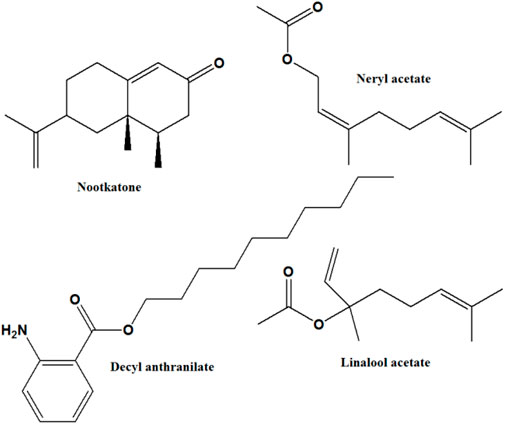- 1Department of Pharmacognosy, Faculty of Pharmacy, Ain Shams University, Cairo, Egypt
- 2Center of Drug Discovery, Research and Development, Faculty of Pharmacy, Ain Shams University, Cairo, Egypt
- 3Environmental Biomonitoring Laboratory LBE (LR01/ES14), Faculty of Sciences Bizerta, Carthage University, Zarzouna, Tunisia
- 4Faculty of Medicine, New Giza University, Giza, Egypt
- 5Department of Medicinal Chemistry, Faculty of Pharmacy, King Salman International University (KSIU), South Sinai, Egypt
- 6Department of Biology, Science Faculty, Selcuk University, Konya, Türkiye
- 7Department of Pharmaceutical Sciences, College of Pharmacy and Thumbay Research Institute for Precision Medicine, Gulf Medical University, Ajman, United Arab Emirates
- 8Department of Pharmaceutical Organic Chemistry, Faculty of Pharmacy, Cairo University, Cairo, Egypt
- 9Department of Medical Physiology, College of Medicine, King Khalid University, Asir, Saudi Arabia
- 10Department of Pharmaceutical Chemistry, Faculty of Pharmacy, Kafrelsheikh University, Kafrelsheikh, Egypt
Introduction: The genus Citrus comprises a large number of economically important fruit crops. They are recognized globally as functional foods and in the food, pharmaceutical, and cosmetic industries.
Methods: We present herein the chemical composition of the hexane extracts of Citrus aurantium (bitter orange) fruits and leaves by GC-MS for the first time, in addition to their antioxidant and enzyme inhibitory activities in vitro.
Results and Discussion: GC-MS revealed nootkatone (15.29%), decyl anthranilate (11.58%), neryl acetate (7.83%), and linalool acetate (6.83%) as major components of fruit extract; while the leaves extract contained mainly lupeol (24.32%), linalool (16.47%), friedelan-3-one (16.40%) and linalool acetate (12.31%). The extracts showed potential inhibitory activities against acetylcholinesterase (AChE), butyrylcholinesterase (BChE), tyrosinase, amylase, and glucosidase enzymes. Results were confirmed by in silico molecular docking studies on the respective enzymes' active sites, viz NADPH oxidase, BChE, tyrosinase, α-amylase, and α-glucosidase. Amongst the docked compounds, lupeol showed the best binding affinities to NADPH oxidase, butyrylcholinesterase BChE, and α- glucosidase; while linalool acetate and neryl acetate showed the best activities against tyrosinase and α-amylase enzymes, respectively. In conclusion, bitter orange waste products can be a potentially important source of antioxidants and useful supplements.
1 Introduction
The genus Citrus belongs to the family Rutaceae, and comprises various species of diverse sizes and forms, such as Citrus sinensis (orange), Citrus reticula (mandarine), Citrus limon (lemon), Citrus paradise (grapefruit), and Citrus junos (yuzu) (Ashmawy et al., 2024). Citrus plants are economically important fruit crops. Annual production of Citrus plants has accomplished more than 126 million tons (FAO, 2017), whereas, 25 million of which were produced in the Mediterranean region. Plants of the genus Citrus are recognized for their fruits, juices, and also as functional foods. In addition, Citrus varieties are used in the food industry and their essential oils are extensively used in the pharmaceutical and cosmetic industries (Bouabdallah et al., 2022; De Pasquale et al., 2006). Citrus species are rich in essential oils, vitamins B9, E, and C, antioxidants, dietary fiber, and coumarins with important health-promoting properties (Hwang et al., 2012; Othman et al., 2016; Ashmawy et al., 2019). Despite, the chemical composition of Citrus essential oils has been extensively studied in various studies, differences in their phytoconstituents were observed due to the differences in the species/cultivars, climate, origin, season, ripening stage, extraction, and analytical methods used (Bouabdallah et al., 2022; De Pasquale et al., 2006; Bora et al., 2020).
Citrus aurantium L (Citrus aurantium) commonly named bigarade, sour, or bitter orange, is an enduring tree that can extend up to 5 m tall, characterized by its white flowers. It is native to Africa and Syria but was cultivated in Spain, the United States, and Italy (Bora et al., 2020; Hosni et al., 2010). The chemical composition of the essential oil of C. aurantium (bitter orange) was evaluated in various plant parts during different seasons (Elshafie, 2022; Djenane, 2015). Many studies were focused on oils from C. aurantium peels and limonene was found to be the major component (Hosni et al., 2010; Elshafie, 2022; Djenane, 2015; Radan et al., 2018; Sarrou et al., 2013; Mohagheghniapoura et al., 2018; Sanei-Dehkordi et al., 2016; Azanchi et al., 2014; Khodabakhsh et al., 2015; Hsouna et al., 2013). However, the volatile constituents from leaves and fruits have not received much attention in the literature, except for a few studies (Radan et al., 2018; Hsouna et al., 2013) that studied the leaves and showed that linalool was the main essential oil component. C. aurantium essential oils have been reported for their antioxidant, anti-inflammatory, insecticidal antibacterial, and antifungal activities (Radan et al., 2018; Hsouna et al., 2013; Bnina et al., 2019; Ben Hsouna et al., 2019).
To the best of our knowledge, there are no reports concerning the fruit rind volatiles or the n-hexane extract from leaves and fruits of C. aurantium. Thus, the main objective of the current study is to explore the composition of n-hexane leaves and fruit extracts of C. aurantium and to evaluate their antioxidant and enzyme inhibitory potentials against acetylcholinesterase (AChE), butyrylcholinesterase (BChE), tyrosinase, amylase, and glucosidase enzymes. Molecular docking studies were also carried out on the major components of each extract to confirm the observed results.
2 Materials and methods
2.1 Plant material and extraction
2.1.1 Preparation of the n-hexane extract
The fresh leaves and fruit peels of Citrus aurantium (100 g) were obtained from a private farm in Menoufia, Egypt. The Voucher specimen was kept at the herbarium of the Pharmacognosy Department, Ain Shams University, Egypt (code: PHG-P-CA-461). The fresh leaves and fruits parts were extracted with n-hexane three times separately. The filtrate was completely evaporated in vacuo at 40°C until dryness to obtain the dried residue of the n-hexane extract (2.4, 2.2 g). Both extracts were stored separately in a refrigerator for further analysis.
2.2 Gas chromatography/mass spectrometry (GC-MS)
The GC-MS of the n-hexane extracts was accomplished using a Shimadzu GCMS-QP equipment with a TRACE GC Ultra Gas Chromatograph (THERMO Scientific Corp., United States), conjugated with a thermo-mass detector at the Pharmacognosy Department, Ain Shams University, Cairo, Egypt. The GC-MS had a TG-5MS capillary column (30 m × 0.25 mm i. d., 0.25 μm film thickness) (Restek, United States). The capillary column was directly coupled to a quadrupole mass spectrometer (SSQ 7000; Thermo-Finnigan). Analysis of a diluted sample (1% v/v; injected volume = 1 µL) was carried out using helium as carrier gas at a constant flow rate of 1.0 mL/min and a split ratio of 1:15. The oven temperature was adjusted at 80°C for 2 min (isothermal), then raised 5.0 °C/min to reach 300°C (programmed) and held for 5 min (isothermal). The injector and detector temperature were held at 280°C. The mass spectra were obtained by adjusting the following parameters as follow: interface temperature = 280°C, ion source temperature = 200°C, and electron ionization (EI) mode = 70 eV, using a scan spectral range at m/z 35–500. The relative proportions of the n-hexane extract constituents were expressed as percentages obtained by peak area normalization.
2.3 GC-MS identification of chemical components of the n-hexane extracts
The components of the n-hexane extracts were tentatively considered by matching their GC-MS spectra, fragmentation patterns, mass numbers, and Kovats retention indices with those published in the Wiley, NIST library and literature reports (Taha and Eldahshan, 2017; Abd El-Ghffar et al., 2017; Shahat et al., 2017; Azab et al., 2017; Eldahshan and Halim, 2016). The retention indices were calculated relative to a homologous series of n-alkanes (C8-C28) injected under the same conditions. The peak area percent of each compound relative to the area percent of the entire FID chromatogram (100%) was calculated.
2.4 Antioxidant assays
Antioxidant assays were carried out according to previously reported methodologies (Zengin et al., 2023a; Zengin et al., 2023b). The antioxidant potential was expressed as mg Trolox equivalents (TE)/g extract in 2,2-diphenyl-1-picrylhydrazyl (DPPH) and 2,20 -azino-bis (3-ethylbenzothiazoline6-sulfonic acid) (ABTS) radical scavenging, cupric reducing antioxidant capacity (CUPRAC), and ferric reducing antioxidant power (FRAP) tests, mmol TE/g extract in phosphomolybdenum assay (PBD), and mg ethylenediaminetetraacetic acid equivalents (EDTAE)/g extract in metal chelating assays (MCA).
For DPPH activity, 1 mL of sample (1 mg/mL) was added to 4 mL of DPPH dissolved in methanol (0.004%). Then after 30 min in dark, the absorbance was read at 517 nm.
ABTS activity was assessed for which 1 mL of sample (1 mg/mL) was added to 2 mL of ABTS solution. The sample absorbance was measured at 734 nm after 30 min at room temperature.
For CUPRAC, 0.5 mL of sample (1 mg/mL) was added to 3 mL of CUPRAC reaction mixture and the absorbance was read at 450 nm after incubation at room temperature for 30 min.
For FRAP, 0.1 mL of sample (1 mg/mL) was added to 2 mL FRAP reagent and absorbance was read at 593 nm after a 30 min incubation at room temperature.
Regarding phosphomolybdenum, 0.3 mL of sample (1 mg/mL) was addedd to 3 mL of reagent and after 90 min at 95°C, the absorbance was read at 695 nm.
Considering the metal chelating activity, 2 mL of sample (1 mg/mL) was added to 0.05 mL of ferrous chloride solution (2 mM) with adding 0.2 mL of 5 mM ferrozine then absorbance was read at room temperature at 562 nm after 10 min.
2.5 Enzyme inhibitory assays
The enzyme inhibitory assays were carried out according to previously reported methodologies (Zengin et al., 2023a; Zengin et al., 2023b). The acetylcholinesterase (AChE) and butyrylcholinesterase (BChE) inhibition were expressed as mg galanthamine equivalents (GALAE)/g extract; tyrosinase inhibition was expressed as mg kojic acid equivalents KAE/g extract; amylase and glucosidase inhibition were expressed as mmol acarbose equivalents (ACAE)/g extract.
For each of AChE or BChE inhibitory activities, 50 μL of sample solution (1 mg/mL); was mixed with 125 μL DTNB (5,5-dithio-bis(2-nitrobenzoic) acid, Sigma, St. Louis, MO, United States) and 25 μL AChE or BChE in Tris–HCl buffer (pH 8.0) incubated at 25°C for 15 min. The reaction was initiated with 25 μL of acetylthiocholine iodide (ATCI) or butyrylthiocholine chloride (BTCl), a blank is done and the absorbance of the blank was subtracted from sample.
25 μL of sample (1 mg/mL) was added to 40 μL tyrosinase solution and 100 μL phosphate buffer (pH 6.8) for determination of tyrosinase activity after 15 min at 25°C. The reaction was initiated with 40 μL L-DOPA. A blank is done without tyrosinase solution. The absorbance at 492 nm of blank was subtracted from sample.
For α-amylase activity, 25 μL of sample (1 mg/mL) was added to 50 μL α-amylase solution in phosphate buffer (pH 6.9) after which it was incubated for 10 min at 37°C. The reaction was initiated by adding 50 μL starch solution and leave 10 min at 37°C. The reaction was stopped by 1 M HCl (25 μL). Then add 100 μL iodine-potassium iodide solution. nm. The absorbance of blank was subtracted from sample at 630.
For α-glucosidase activity, 50 μL of sample (1 mg/mL) was added to equal volumes of each of glutathione and α-glucosidase solution in phosphate buffer (pH 6.8) and PNPG (4-N-trophenyl-α-D-glucopyranoside, Sigma) and incubated for 15 min at 37°C. Ablank was done without the enzyme and reaction was stopped by 50 μL sodium carbonate (0.2 M). The absorbance at 400 nm of blank was subtracted from that of the sample.
2.6 Docking study
The X-ray 3D structures of NADPH oxidase, butyrylcholinesterase, tyrosinase, α-amylase, and α-glucosidase were downloaded from the protein data bank using the following IDs: 2cdu, 6esj, 5m8q, 4gqq and 3wy2, respectively. Vina autodock and MGL tools were employed to conduct the docking studies (Trott and Olson, 2010; El Hassab et al., 2021). The major compounds identified in the n-hexane fruit and leaves extract of C. aurantium were implemented in the docking study. All five receptors and the six compounds were saved in a pdbqt format using MGL tools as an essential requisite by Vina autodock. The active site of each target was determined from the binding of the corresponding co-crystalized ligand. Finally, the docking results were inspected by the Discovery Studio visualizer which was also used to generate the 2D interaction diagrams (Shady et al., 2022; El-Nashar et al., 2023).
3 Results
3.1 GC-MS of C. aurantium fruit extract
Twenty-five compounds were tentatively identified from the n-hexane fruit extract of C. aurantium, representing about 90.59% of the total peak area, and are presented in Table 1. Major identified compounds are shown in Figure 1.
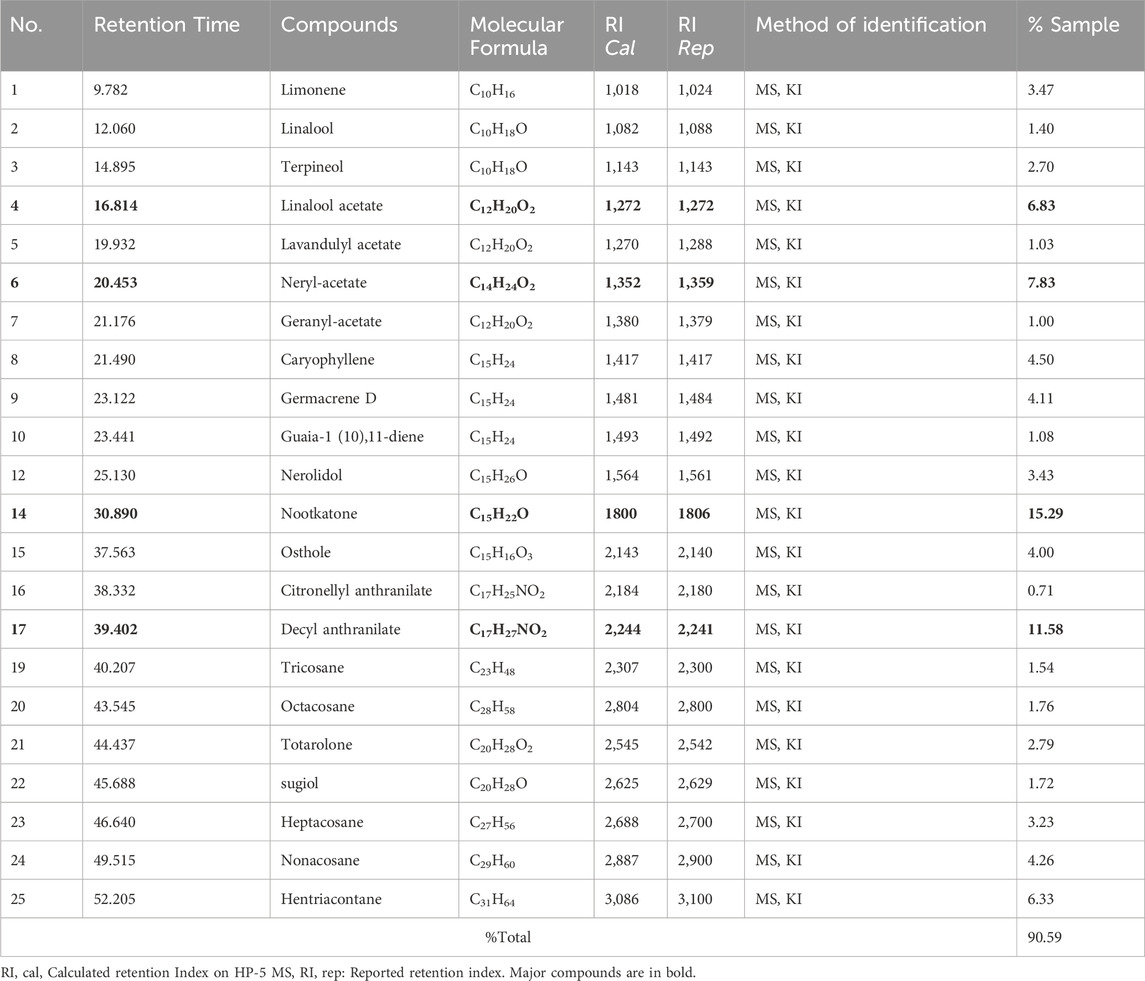
Table 1. The chemical composition of the n-hexane fruit extract of C. aurantium was tentatively identified by GC-MS.
3.2 GC-MS of C. aurantium leaves extract
Thirteen compounds were tentatively identified from the n-hexane leaves extract of C. aurantium, representing about 90.34% of the total peak area, and are presented in Table 2. Major identified compounds are shown in Figure 2.
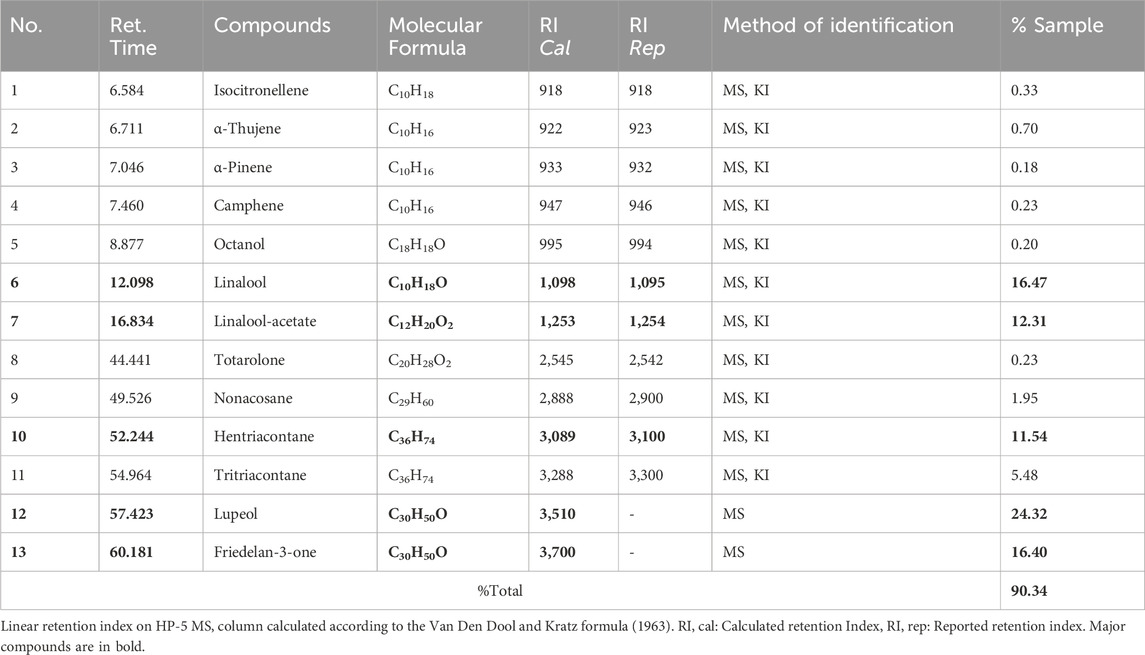
Table 2. Chemical composition of n-hexane leaves extract of C. aurantium tentatively identified by GC-MS.
3.3 Total bioactive components and antioxidant properties
In the present study, we determined the total content of phenolics and flavonoids in the tested extracts using spectrophotometric methods. As can be seen in Table 3, the leaf (13.61 mg GAE/g) and fruit extracts (13.24 mg GAE/g) contained almost part of the total phenol content. However, the total flavonoid content in leaf extract (6.31 mg RE/g) was higher than that of fruits (2.15 mg RE/g).
The antioxidant properties of n-hexane extracts were investigated through various chemical tests, including radical scavenger (DPPH and ABTS), reducing capacity (CUPRAC, FRAP and phosphomolybdenum) and metal chelation. The results are summarized in Table 3. In DPPH and ABTS assays, the leaf extract (DPPH: 13.96 mg TE/g; ABTS: 19.92 mg TE/g) showed a stronger ability than the fruit extract (DPPH: 5.83 mg TE/g; ABTS: 13.44 mg TE/g). Similar to tests on the radical scavenger, leaf extract was found to have the best reducing abilities compared to the fruit extract. In addition, the metal chelating capacity of leaves (29.02 mg EDTAE/g) was higher than that of fruits (22.53 mg EDTAE/g).
3.4 Enzyme inhibitory effects
The enzyme inhibitory effects of the tested extracts were investigated against several enzymes including cholinesterase (AChE and BChE), tyrosinase, amylase and glucosidase. The results are given in Table 4. In cholinesterase inhibition assays, the fruit extract (2.51 mg GALAE/g) exhibited more potent inhibitory effect on AChE than the leaves extract (1.63 mg GALAE/g); while the leaves extract (2.24 mg GALAE/g) displayed a higher inhibitory effect on BChE as compared to the fruits extract (1.70 mg GALAE/g). Regarding tyrosinase inhibition, the leaves extract (50.71 mg KAE/g) had a stronger inhibitory effect than fruit (46.46 mg KAE/g). Like tyrosinase inhibition, the leaves extract (0.53 mmol ACAE/g) was more active on amylase compared to fruit (0.43 mmol ACAE/g). However, the glucosidase inhibition effect of fruit (2.27 mmol ACAE/g) was higher than the leaves extract (2.13 mmol ACAE/g).
3.5 Molecular docking study
The major compounds identified in n-hexane fruit and leaves extract of C. aurantium, neryl acetate, nootkatone, linalool acetate, decyl anthranilate, friedelan-3-one, lupeol and linalool were docked into the active site vicinity of the five enzymes (i.e., NADPH oxidase, butyrylcholinesterase, tyrosinase, α-amylase, and α-glucosidase). As presented in Table 5, all compounds achieved acceptable binding scores when docked with the five targets.
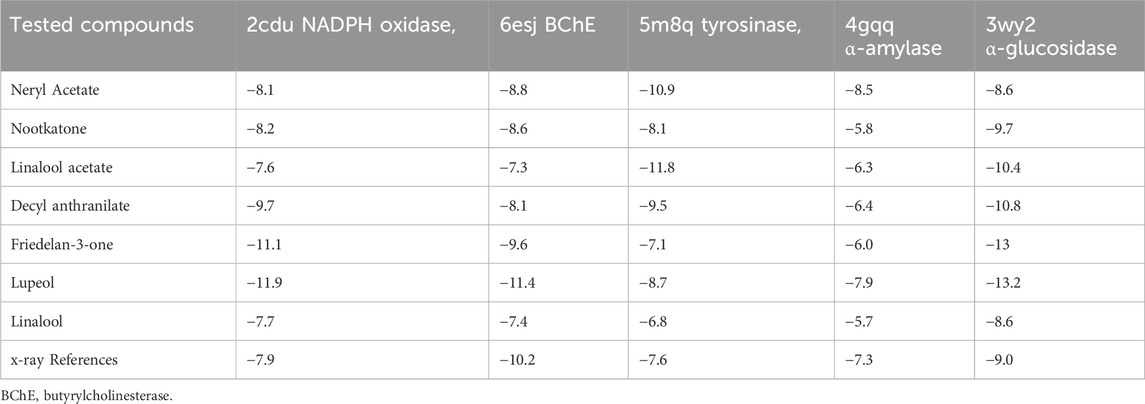
Table 5. Docking binding scores of major compounds in n-hexane extracts of fruit and leaves of C. aurantium.
For the NADPH oxidase, the seven compounds achieved docking scores from −7.6 to −11.9 kcal/mol, where Lupeol and Friedelan-3-one were the best compounds achieving scores of −11.9 and −11.1 kcal/mol, respectively. Inspecting Figure 3, Lupeol interacted with Tyr188 through hydrogen bond interactions and with His10, Lys134, Tyr159, Tyr188, Phe245, Pro298, Leu299 and Ala300 through hydrophobic interactions, while Friedelan-3-one formed only hydrophobic interaction with His10, Phe245, Ala300 and Ala303.
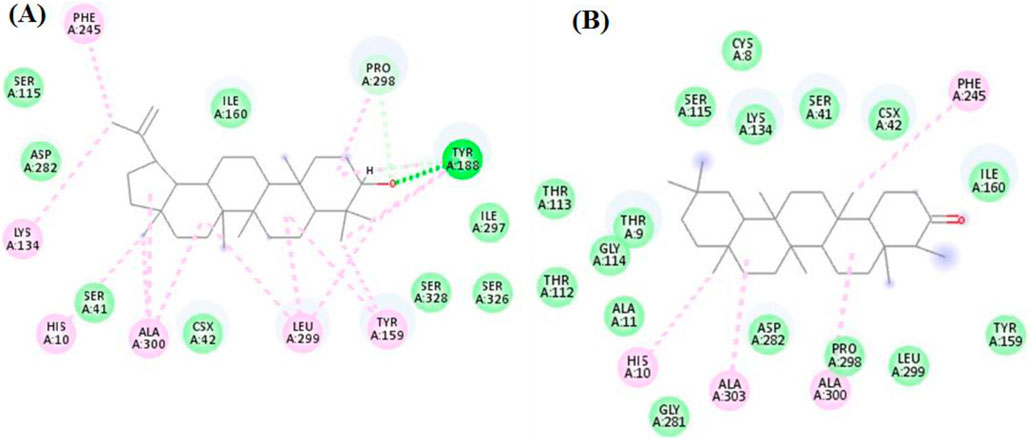
Figure 3. The docking of (A) Lupeol (B) Friedelan-3-one in the active site of NADPH oxidase enzyme (PDB code: 2cdu).
For the BChE enzyme, the seven compounds achieved docking scores from −7.3 to −11.4 kcal/mol, where Lupeol and Friedelan-3-one were the best compounds achieving scores of −11.4 and −9.6 kcal/mol, respectively. As seen in Figure 4, Lupeol formed several hydrophobic interactions with Trp82, Leu125, Tyr128, His438, and one hydrogen bond with Thr120. Similarly, Friedelan-3-one formed hydrophobic interactions with Trp82, Pro285, Tyr332, and His438.
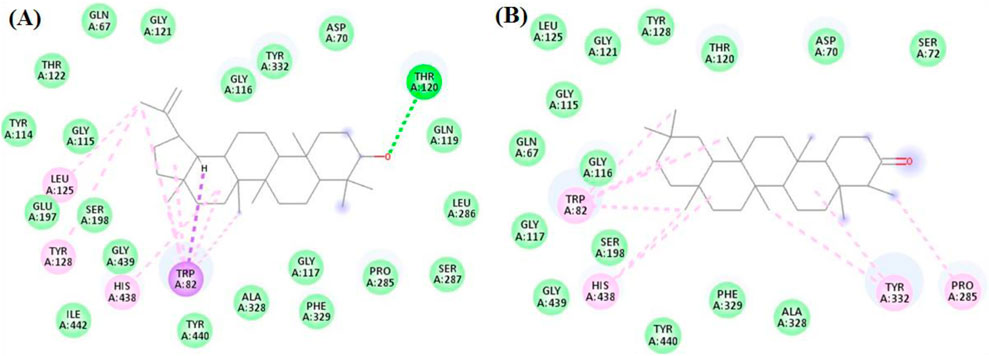
Figure 4. The docking of (A) Lupeol, (B) Friedelan-3-one in the active site of BChE enzyme (PDB code: 6esj).
The seven compounds achieved docking scores ranged from −6.8 to −11.8 kcal/mol against the tyrosinase enzyme. Neryl Acetate and Linalool acetate achieved the best scores −10.9 and −11.8 kcal/mol, respectively. As Figure 5 revealed, Neryl Acetate formed several interactions with His215, His377, His 381, Leu382, Val391, and Ser394. Likewise, Linalool acetate interacted with His215, Phe362, His377, His 381, Leu382, and Val391.

Figure 5. The docking of (A) Neryl Acetate, (B) Linalool acetate in the active site of tyrosinase enzyme (PDB code: 5m8q).
In the docking with α-amylase, the major compounds achieved good scores ranging from −5.7 to −8.5 kcal/mol. Amongst, Neryl Acetate and Lupeol were the best compounds with scorers −8.5 and −7.9 kcal/mol, respectively. As seen in Figure 6, Neryl Acetate interacted with Tyr468, and His476 through both hydrophobic and hydrogen bond interactions. On the other hand, Lupeol formed both hydrophobic and hydrogen bond interactions with His476 and Ser478, respectively.
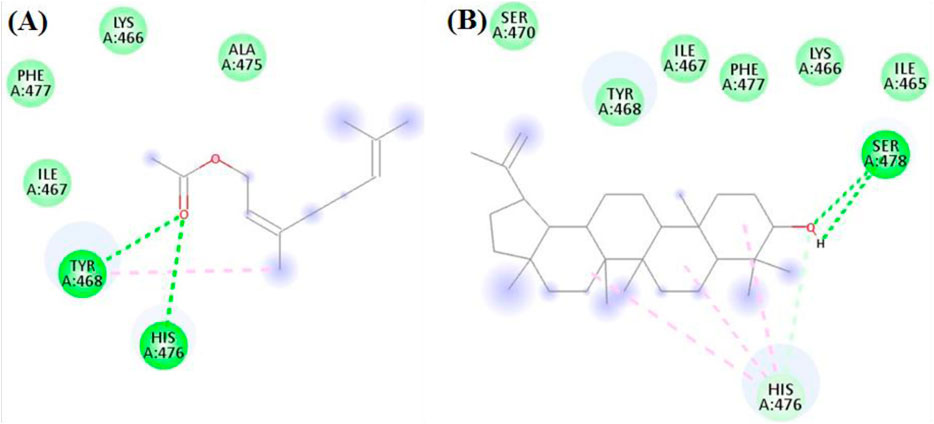
Figure 6. The docking of (A) Neryl Acetate, and (B) Lupeol, in the active site of amylase enzyme (PDB code: 4gqq).
For glucosidase, the seven investigated compounds achieved excellent docking scores from −8.6 to −13.2 kcal/mol. Lupeol and Friedelan-3-one achieved docking scores of −13.2 and −13 kcal/mol, respectively, ranking the best two compounds.
Inspecting their interactions as shown in Figure 7, it was found that Lupeol interacted with, Ile146, Phe166, Phe206, Pro230, Phe297, Val334, Arg340, Tyr389, and Phe397 through hydrophobic interactions, while it formed one hydrogen bond with Gly273. Similarly, Friedelan-3-one interacted with Tyr65, Ile146, Phe147, Phe166, Phe206, Pro230, Phe297, His332 and Val334, through only hydrophobic interactions.
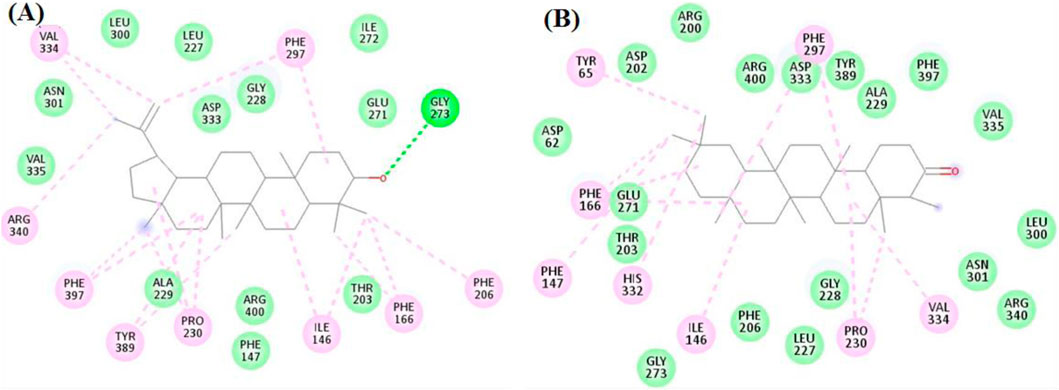
Figure 7. The docking of (A) Lupeol, and (B) Friedelan-3-one in the active site of glucosidase enzyme (PDB code: 3wy2).
4 Discussion
Phenolic compounds are considered multidirectional agents in the development of functional pharmaceuticals and nutraceuticals. Therefore, determining the total phenol content in a plant extract can reveal its biological potential (Mostafa et al., 2018). In this sense, the total bioactive compounds in the extracts were examined and their phenol content was almost the same. However, their total flavonoid content in leaves was almost three times higher than in fruits. In the literature, several authors reported different concentrations of the total bioactive compounds. For example, Lagha-Benamrouche and Madani found that the total phenol content in the leaf extracts of several Citrus varieties was between 12.54 and 44.41 mg GAE/g. In another study by Mejri et al., (2023), the total phenolic content of the young leaves of C. aurantium was 98.11 mg GAE/g (Mejri et al., 2023). Wang et al. (2023) optimized the extraction of phenolics in the leaves of C. aurantium and the level of the total phenolic was 69.09 mg GAE/g in the optimal condition (Wang et al., 2023). In recent years, though, the spectrophotometric results have caused some concern. The results of the tests may be questionable, particularly because the phytochemicals are complex and specific compounds as well as other ingredients may react with the reagent. Further chromatographic techniques are therefore required to validate the results.
The GC-MS of Citrus aurantium (C. aurantium) extract reveals a rich profile of bioactive compounds, underscores its significant therapeutic potential. This complex chemical composition positions C. aurantium as a versatile ingredient for natural health products, with applications in antioxidant, anti-inflammatory, cognitive, and metabolic therapies (Raut and Karuppayil, 2014; Bouabdallah et al., 2022).
The n-hexane extract from C. aurantium leaves exhibits higher concentrations of linalool and other terpenes that are less prominent in the fruit extract. Linalool, in particular, is associated with sedative, anxiolytic, and anti-inflammatory properties, making leaf extracts particularly valuable for stress relief and inflammation management. The leaves also contain distinctive secondary metabolites not commonly present in the fruit, which contribute to the plant’s defense mechanisms and enhance its therapeutic potential (Chutia et al., 2009).
The chemical composition of volatile components can vary significantly depending on the locality, which affects factors like soil composition, climate, season of collection and altitude (Elhawary et al., 2021; Rabie et al., 2023). Comparative studies on C. aurantium from Tunisia, Morocco, and other Mediterranean regions highlight variations in the concentration of bioactive compounds in essential oils and extracts, such as limonene, linalool, β-myrcene, α-pinene, and flavonoids. Studies on Tunisian C. aurantium essential oils have generally reported high concentrations of limonene and linalool. The Tunisian climate, characterized by a Mediterranean influence with hot summers and mild winters, appears to favor the production of these monoterpenes. For, example, Hosni et al. (2010) found that the essential oils of Tunisian C. aurantium are rich in limonene, which can exceed 90% of the volatile fraction. This limonene dominance is associated with strong antioxidant and anti-inflammatory potential, reflecting the suitability of Tunisian C. aurantium for applications in antioxidant therapies and skincare products (Karoui and Marzouk, 2013).
In Moroccan C. aurantium, linalool and limonene were also major components, yet with slightly different proportions compared to Tunisian sources. Moroccan C. aurantium essential oils tend to have a higher proportion of linalool, which is notable for its anxiolytic and sedative effects. This difference is attributed to Morocco’s diverse microclimates, especially in regions with higher altitudes, which seem to enhance the production of compounds with calming properties (Bendaha et al., 2016). Studies have found that Moroccan C. aurantium extracts are therefore well-suited for applications in aromatherapy and stress relief products. Egyptian C. aurantium, like the samples from Menoufia, Egypt, has a unique profile influenced by the region’s hot and arid conditions. Extracts from the Egyptian chemotype have shown the presence of synephrine, an alkaloid valued for metabolic and stimulant effects, along with limonene and β-myrcene (Ashmawy et al., 2024).
Antioxidants play a protective role against the attacks of free radicals, which trigger the development of serious health problems such as cancer, diabetes or cardiovascular diseases. In addition to health-promoting effects, antioxidants delay lipid peroxidation and thus improve the shelf life of foods in the nutraceutical sector. In this sense, identifying effective and safe sources of antioxidants is one of the most popular topics on the scientific platform. In the study, we determined the antioxidant properties of the tested extracts using in vitro methods. In all antioxidant tests, leaf extract was more active than fruit extracts. For example, the ability of leaf extract to intercept DPPH was 2.5 times higher than that of fruit extract. In the literature, several researchers reported significant antioxidant properties of leaves of C. aurantium compared to other parts (Mejri et al., 2023; Wang et al., 2023). The antioxidant ability of the leaves extract can be attributed to the presence of some compounds such as lupeol and linalool. For example, Tchimene et al. (2016) isolated lupeol from the leaves of Crateva adansonii and it showed significant capabilities to scavenge DPPH and ABTS as well as an ability to reduce iron (Tchimene et al., 2016).
In addition to DPPH and FRAP, Lupeol had a high capacity to scavenge superoxide, nitric oxide, and hydroxyl radicals, lupeol had great superoxide, nitric oxide and hydroxyl radical scavenging ability (Park et al., 2023). Chaudhary et al. (2023) investigated antioxidant effects of some essential oils and their main components and they reported significant DPPH radical scavenging ability of linalool. Linalool also exhibited significant antioxidant effect in DPPH and FRAP assays. The presence of double bond and hydroxyl group may contribute to the antioxidant effect of linalool.
The theory of enzyme inhibition is currently gaining interest in pharmaceutical applications.
Inhibiting important enzymes can alleviate the symptoms of serious health problems such as diabetes, obesity, or Alzheimer’s. Acetylcholinesterase, for example, is a major target in the treatment of Alzheimer’s disease. Their inhibition led to an increase in acetylcholine levels in the synaptic gap and can therefore improve cognitive functions in Alzheimer patients. Similarly, inhibiting amylase and glucosidase can control blood sugar levels in diabetics, which forms the basis for oral antidiabetic drugs. In this sense, several compounds were produced as enzyme inhibitors, but most of them had adverse side effects. We need therefore to find alternative and safe enzyme inhibitors. Based on these informations, we investigated the enzyme-inhibiting properties of the tested extracts. All extracts inhibited the tested enzymes. The fruit extract showed greater AChE and glucosidase inhibition, but the leaf extract was more active against BChE, tyrosinase, and amylase. In particular, the presence of lupeol in leaf extract can be attributed to enzyme inhibition. Lupeol, as a natural compound with minimal reported toxicity, offers a safer alternative with potentially comparable efficacy, making it a promising candidate for therapeutic development (Park et al., 2023). Lupeol, a naturally occurring triterpenoid, has demonstrated notable inhibitory activity against BChE, an enzyme implicated in neurodegenerative disorders like Alzheimer’s disease. BChE inhibition is particularly significant in late-stage Alzheimer’s, where its activity surpasses acetylcholinesterase (AChE) (Park et al., 2023).
Molecular docking studies have shown that lupeol binds effectively to the active site of BChE, forming stable interactions with key residues, which contributes to its potent inhibitory effect. These interactions involve hydrophobic and hydrogen bonds, enhancing its specificity for BChE over AChE in some cases (Park et al., 2023). Previous studies have reported lupeol’s BChE inhibition with IC50 values in the micromolar range, highlighting its therapeutic potential as a neuroprotective agent. Furthermore, lupeol’s natural origin and low toxicity make it an attractive candidate for drug development targeting cholinesterase-related pathologies (Saleem, 2009). Lupeol has shown significant inhibitory activity against alpha-glucosidase, an enzyme involved in the breakdown of carbohydrates into glucose. Molecular docking and in vitro studies suggest that lupeol binds effectively to the active site of alpha-glucosidase, forming hydrogen bonds and hydrophobic interactions with key amino acid residues. These interactions block the enzyme’s catalytic activity, thereby reducing glucose absorption in the intestine. Previous studies have reported that lupeol exhibits alpha-glucosidase inhibition with IC50 values in the low micromolar range, comparable to standard antidiabetic drugs like acarbose (Lee et al., 2021). Additionally, its natural origin, combined with antioxidant properties, supports its dual role in glycemic control and protection against oxidative stress associated with diabetes (Lee et al., 2021). In addition to the enzyme-inhibiting effect of lupeol, linalool has been reported as a significant enzyme inhibitor. Alimi et al. (2022) for example, reported a significant AChE inhibitor effect with linalool with an IC50 value of 0.428 mg/mL (Alimi et al., 2022). In addition, López and Pascual-Villalobos (2010) found that linalool competitively inhibited AChE action (López and Pascual-Villalobos, 2010). In the literature, several researchers reported the enzyme-inhibiting potential of members of the genus Cistus, including C. aurantium (Ashmawy et al., 2024). In this sense, the genus Cistus can be considered an effective source of natural enzyme inhibitors.
In the current study, based on the obtained results for the tested biological activities, lupeol achieved the highest docking scores of −11.9, −11.4, and −13.2 kcal/mol for NADPH oxidase, butyrylcholinesterase, and α-glucosidase, respectively. Docking studies of lupeol, a naturally occurring triterpenoid, with NADPH oxidase provide insights into its potential as an inhibitor of oxidative stress pathways (Park et al., 2023). NADPH oxidase is an enzyme complex that produces reactive oxygen species (ROS) as part of cellular signaling and immune response. However, excessive ROS generation due to overactive NADPH oxidase is implicated in various pathological conditions, including cancer, neurodegenerative diseases, and cardiovascular disorders. Lupeol’s interaction with NADPH oxidase could help modulate this enzyme’s activity, offering therapeutic benefits (Park et al., 2023).
In docking studies, lupeol has demonstrated favorable binding affinities within the active or allosteric sites of NADPH oxidase. The molecular structure of lupeol, characterized by its hydrophobic triterpenoid skeleton, allows it to interact effectively with hydrophobic pockets in NADPH oxidase. These interactions may involve hydrogen bonding, hydrophobic interactions, and van der Waals forces with key amino acid residues in NADPH oxidase. Specific residues in the active site, such as those contributing to electron transport, can interact with lupeol, potentially interfering with the enzyme’s ROS-producing function (Chaudhary et al., 2023).
By binding to NADPH oxidase, lupeol may inhibit its activity, thus reducing ROS levels and mitigating oxidative stress. This antioxidant effect could play a role in preventing or slowing the progression of diseases where oxidative damage is a key factor. For instance, in cancer, reducing ROS production could suppress tumor growth and proliferation, as ROS can promote cancer cell survival through multiple pathways (Nakamura and Takada, 2021). Similarly, in neurodegenerative diseases, lowering ROS levels could help protect neurons from oxidative damage, which is central to conditions like Alzheimer’s and Parkinson’s (Nakamura and Takada, 2021).
Lupeol’s docking affinities and binding interactions with NADPH oxidase may be compared to other known NADPH oxidase inhibitors, such as apocynin or diphenyleneiodonium. While synthetic inhibitors often exhibit strong inhibitory effects, they may also produce side effects.
5 Conclusion
The current study focused on Citrus aurantium, a rich source of bioactive compounds, including nootkatone, decyl anthranilate, neryl acetate, and linalool acetate in fruit hexane extract; and lupeol, linalool, friedelan-3-one and linalool acetate in the leaves extract. The extracts showed in vitro bioactivity against AChE, BChE, tyrosinase, amylase, and glucosidase enzymes. These were further confirmed by in silico docking studies. The results highlight its therapeutic potential as an antioxidant, neuroprotective, and antidiabetic agent, positioning Citrus aurantium as a promising natural source for multi-targeted therapies.
Data availability statement
The original contributions presented in the study are included in the article further inquiries can be directed to the corresponding authors.
Author contributions
OE: Conceptualization, Data curation, Formal Analysis, Validation, Writing – original draft, Writing – review and editing. SB: Visualization, Writing – original draft, Writing – review and editing, Data curation, Methodology. RA:Methodology, Writing – original draft, Writing – review, and editing, Formal Analysis, Investigation. ME: Formal Analysis, Software, Visualization, Writing – original draft, Writing – review and editing. GZ: Data curation, Investigation, Visualization, Writing – original draft, Writing – review and editing. AN: Investigation, Methodology, Software, Writing – original draft, Writing – review and editing. EK: Data curation, Funding acquisition, Investigation, Resources, Writing – original draft, Writing – review and editing. WE: Conceptualization, Data curation, Validation, Writing – original draft, Writing – review and editing. NM: Conceptualization, Data curation, Project administration, Visualization, Writing – original draft, Writing – review and editing.
Funding
The author(s) declare that financial support was received for the research and/or publication of this article. The authors extend their appreciation to the Deanship of Research and Graduate Studies at King Khalid University for funding this work through small group research under grant number (RGP1/132/46).
Conflict of interest
The authors declare that the research was conducted in the absence of any commercial or financial relationships that could be construed as a potential conflict of interest.
The author(s) declared that they were an editorial board member of Frontiers, at the time of submission. This had no impact on the peer review process and the final decision.
Generative AI statement
The author(s) declare that no Generative AI was used in the creation of this manuscript.
Publisher’s note
All claims expressed in this article are solely those of the authors and do not necessarily represent those of their affiliated organizations, or those of the publisher, the editors and the reviewers. Any product that may be evaluated in this article, or claim that may be made by its manufacturer, is not guaranteed or endorsed by the publisher.
References
Abd El-Ghffar, E. A., El-Nashar, H. A., Eldahshan, O. A., and Singab, A. N. (2017). GC-MS analysis and hepatoprotective activity of the n-hexane extract of Acrocarpus fraxinifolius leaves against paracetamol-induced hepatotoxicity in male albino rats. Pharm. Biol. 55 (1), 441–449. doi:10.1080/13880209.2016.1246575
Alimi, D., Hajri, A., Jallouli, S., and Sebai, H. (2022). Acaricidal and anthelmintic efficacy of Ocimum basilicum essential oil and its major constituents estragole and linalool, with insights on acetylcholinesterase inhibition. Veterinary Parasitol. 309, 109743. doi:10.1016/j.vetpar.2022.109743
Ashmawy, A., Mostafa, N., and Eldahshan, O. (2019). GC/MS analysis and molecular profiling of lemon volatile oil against breast cancer. J. Essent. Oil Bear. Plants 22, 903–916. doi:10.1080/0972060x.2019.1667877
Ashmawy, N. S., Nilofar, N., Zengin, G., and Eldahshan, O. A. (2024). Metabolic profiling and enzyme inhibitory activity of the essential oil of citrus aurantium fruit peel. BMC Complementary Med. Ther 24, 262. doi:10.1186/s12906-024-04505-2
Azab, S. S., Abdel Jaleel, G. A., and Eldahshan, O. A. (2017). Anti-inflammatory and gastroprotective potential of leaf essential oil of Cinnamomum glanduliferum in ethanol-induced rat experimental gastritis. Pharm. Biol. 55 (1), 1654–1661. doi:10.1080/13880209.2017.1314512
Azanchi, T., Shafaroodi, H., and Asgarpanah, J. (2014). Anticonvulsant activity of Citrus aurantium blossom essential oil (neroli): involvment of the GABAergic system. Nat. Prod. Commun. 9, 1615–1618.
Ben Hsouna, A., Gargouri, M., Dhifi, W., Ben Saad, R., Sayahi, N., Mnif, W., et al. (2019). Potential anti-inflammatory and antioxidant effects of Citrus aurantium essential oil against carbon tetrachloride-mediated hepatotoxicity: a biochemical, molecular and histopathological changes in adult rats. Environ. Toxicol. 34, 388–400. doi:10.1002/tox.22693
Bendaha, H., Bouchal, B., El Mounsi, I., Salhi, A., Berrabeh, M., El Bellaoui, M., et al. (2016). Chemical composition, antioxidant, antibacterial and antifungal activities of peel essential oils of Citrus aurantium grown in Eastern Morocco. Der Pharm. Lett. 8 (4), 239–245.
Bnina, E. B., Hajlaoui, H., Chaieb, I., Said, M. B., and Jannet, H. B. (2019). Chemical composition, antimicrobial and insecticidal activities of the tunisian Citrus aurantium essential oils. Czech J. Food Sci. 37, 81–92. doi:10.17221/202/2017-cjfs
Bora, H., Kamle, M., Mahato, D. K., Tiwari, P., and Kumar, P. (2020). Citrus essential oils (CEOs) and their applications in food: an overview. Plants 9, 357. doi:10.3390/plants9030357
Bouabdallah, S., Cianfaglione, K., Azzouz, M., El-Saber Batiha, G., Alkhuriji, A. F., Al-Megrin, W. A. I., et al. (2022). Sustainable extraction, chemical profile, cytotoxic and antileishmanial activities in-vitro of some citrus species leaves essential oils. Pharmaceuticals 15 (9), 1163. doi:10.3390/ph15091163
Chaudhary, P., Janmeda, P., Docea, A. O., Yeskaliyeva, B., Abdull Razis, A. F., Modu, B., et al. (2023). Oxidative stress, free radicals and antioxidants: potential crosstalk in the pathophysiology of human diseases. Front. Chem. 11, 1158198. doi:10.3389/fchem.2023.1158198
Chen, X., Shang, S., Yan, F., Jiang, H., Zhao, G., Tian, S., et al. (2023). Antioxidant activities of essential oils and their major components in scavenging free radicals, inhibiting lipid oxidation and reducing cellular oxidative stress. Molecules 28, 4559. doi:10.3390/molecules28114559
Chutia, M., Bhuyan, P. D., Padhak, M. G., Sarma, T. C., and Boruah, P. (2009). Antifungal activity and chemical composition of Citrus reticulata Blanco essential oil against phytopathogens from North-East India. Food Sci. Technol. Int. 42 (3), 777–780. doi:10.1016/j.lwt.2008.09.015
De Pasquale, F., Siragusa, M., Abbate, L., Tusa, N., De Pasquale, C., and Alonzo, G. (2006). Characterization of five sour orange clones through molecular markers and leaf essential oils analysis. Sci. Hortic. 109, 54–59. doi:10.1016/j.scienta.2006.03.002
Djenane, D. (2015). Chemical profile, antibacterial and antioxidant activity of Algerian citrus essential oils and their application in Sardina pilchardus. Foods 4, 208–228. doi:10.3390/foods4020208
Eldahshan, O. A., and Halim, A. F. (2016). Comparison of the composition and antimicrobial activities of the essential oils of green branches and leaves of Egyptian navel orange (citrus sinensis (L.) osbeck var. malesy). Chem. Biodivers. 13 (6), 681–685. doi:10.1002/cbdv.201500139
El Hassab, M. A., Ibrahim, T. M., Al-Rashood, S. T., Alharbi, A., Eskandrani, R. O., and Eldehna, W. M. (2021). In silico identification of novel SARS-COV-2 2′-O-methyltransferase (nsp16) inhibitors: structure-based virtual screening, molecular dynamics simulation and MM-PBSA approaches. J. Enzyme Inhibition Med. Chem. 36 (1), 727–736. doi:10.1080/14756366.2021.1885396
Elhawary, E. A., Mostafa, N. M., Labib, R. M., and Singab, A. N. (2021). Metabolomic profiles of essential oils from selected rosa varieties and their antimicrobial activities. Plants 10 (8), 1721. doi:10.3390/plants10081721
El-Nashar, H. A. S., Sayed, A. M., El-Sherief, H. A. M., Rateb, M. E., Akil, L., Khadra, I., et al. (2023). Metabolomic profile, anti-trypanosomal potential and molecular docking studies of Thunbergia grandifolia. J. Enzyme Inhibition Med. Chem. 38 (1), 2199950. doi:10.1080/14756366.2023.2199950
Elshafie, H. S. (2022). Plant essential oil with biological activity. Plants 11, 980. doi:10.3390/plants11070980
Hosni, K., Zahed, N., Chrif, R., Abid, I., Medfei, W., Kallel, K., et al. (2010). Composition of peel essential oils from four selected Tunisian Citrus species: evidence for the genotypic influence. Food Chem. 123, 1098–1104. doi:10.1016/j.foodchem.2010.05.068
Hsouna, A. B., Hamdi, N., Halima, N. B., and Abdelkafi, S. (2013). Characterization of essential oil from Citrus aurantium L. flowers: antimicrobial and antioxidant activities. J. Oleo Sci. 62, 763–772. doi:10.5650/jos.62.763
Hwang, S.-L., Shih, P.-H., and Yen, G.-C. (2012). Neuroprotective effects of Citrus flavonoids. J. Agric. Food Chem. 60, 877–885. doi:10.1021/jf204452y
Karoui, I. J., and Marzouk, B. (2013). Characterization of bioactive compounds in Tunisian bitter orange (Citrus aurantium L.) peel and juice and determination of their antioxidant activities. Biomed. Res. Int. 2013, 345415. doi:10.1155/2013/345415
Khodabakhsh, P., Shafaroodi, H., and Asgarpanah, J. (2015). Analgesic and anti-inflammatory activities of Citrus aurantium L. blossoms essential oil (neroli): involvement of the nitric oxide/cyclic-guanosine monophosphate pathway. J. Nat. Med. 69, 324–331. doi:10.1007/s11418-015-0896-6
Lee, H.-A., Kim, M.-J., and Han, J.-S. (2021). Alleviating effects of lupeol on postprandial hyperglycemia in diabetic mice. Toxicol. Res. (Camb). 10 (3), 495–500. doi:10.1093/toxres/tfab019
López, M. D., and Pascual-Villalobos, M. J. (2010). Mode of inhibition of acetylcholinesterase by monoterpenoids and implications for pest control. Industrial Crops Prod. 31 (2), 284–288. . doi:10.1016/j.indcrop.2009.11.005
Mejri, H., Aidi Wannes, W., Mahjoub, F. H., Hammami, M., Dussault, C., Legault, J., et al. (2023). Potential bio-functional properties of Citrus aurantium L. leaf: chemical composition, antiviral activity on herpes simplex virus type-1, antiproliferative effects on human lung and colon cancer cells and oxidative protection. Int. J. Environ. Health Res. 34 (2), 1113–1123. doi:10.1080/09603123.2023.2200237
Mohagheghniapoura, A., Saharkhiza, M. J., Golmakanic, M. T., and Niakousari, M. (2018). Variations in chemical compositions of essential oil from sour orange (Citrus aurantium L.) blossoms by different isolation methods. Sustain. Chem. Pharm. 10, 118–124. doi:10.1016/j.scp.2018.10.008
Mostafa, N. M., Abd El-Ghffar, E. A., Hegazy, H. G., and Eldahshan, O. A. (2018). New methoxyflavone from casimiroa sapota and the biological activities of its leaves extract against lead acetate induced hepatotoxicity in rats. Chem. Biodivers. 15 (4), e1700528. doi:10.1002/cbdv.201700528
Nakamura, H., and Takada, K. (2021). Reactive oxygen species in cancer: current findings and future directions. Cancer Sci. 112 (10), 3945–3952. doi:10.1111/cas.15068
Othman, M., Atiqah, S. N., Hassan, M. A., Nahar, L., Basar, N., Jamil, S., et al. (2016). Essential oils from the Malaysian Citrus (Rutaceae) medicinal plants. Medicines 3, 13. doi:10.3390/medicines3020013
Park, J. S., Rehman, I. U., Choe, K., Ahmad, R., Lee, H. J., and Kim, M. O. (2023). A triterpenoid lupeol as an antioxidant and anti-neuroinflammatory agent: impacts on oxidative stress in alzheimer's disease. Nutrients 15 (13), 3059. doi:10.3390/nu15133059
Rabie, O., El-Nashar, H. A. S., Majrashi, T. A., Al-Warhi, T., El Hassab, M. A., Eldehna, W. M., et al. (2023). Chemical composition, seasonal variation and antiaging activities of essential oil from Callistemon subulatus leaves growing in Egypt. J. Enzyme Inhibition Med. Chem. 38 (1), 2224944. doi:10.1080/14756366.2023.2224944
Radan, M., Parcina, A., and Burcul, F. (2018). Chemical composition and antioxidant activity of essential oil obtained from bitter orange peel (Citrus aurantium L.) using two methods. Croat. Chem. Acta 91, 125–128. doi:10.5562/cca3294
Raut, J. S., and Karuppayil, S. M. (2014). A status review on the medicinal properties of essential oils. Industrial Crops Prod. 62, 250–264. doi:10.1016/j.indcrop.2014.05.055
Saleem, M. (2009). Lupeol, a novel anti-inflammatory and anti-cancer dietary triterpene. Cancer Lett. 285 (2), 109–115. doi:10.1016/j.canlet.2009.04.033
Sanei-Dehkordi, A., Sedaghat, M. M., Vatandoost, H., and Abai, M. R. (2016). Chemical compositions of the peel essential oil of Citrus aurantium and its natural larvicidal activity against the malaria vector Anopheles stephensi (Diptera: Culicidae) in comparison with Citrus paradisi. J. Arthropod-Borne Dis. 10, 577–585.
Sarrou, E., Chatzopoulou, P., Dimassi-Theriou, K., and Therios, I. (2013). Volatile constituents and antioxidant activity of peel, flowers and leaf oils of Citrus aurantium L. growing in Greece. Molecules 18, 10639–10647. doi:10.3390/molecules180910639
Shady, N. H., Mostafa, N. M., Fayez, S., Abdel-Rahman, I. M., Maher, S. A., Zayed, A., et al. (2022). Mechanistic wound healing and antioxidant potential of Moringa oleifera seeds extract supported by metabolic profiling, in silico network design, molecular docking, and in vivo studies. Antioxidants (Basel) 11 (9), 1743. doi:10.3390/antiox11091743
Shahat, E. A., Bakr, R. O., Eldahshan, O. A., and Ayoub, N. A. (2017). Chemical composition and biological activities of the essential oil from leaves and flowers of pulicaria incisa sub. Candolleana (family asteraceae). Chem. Biodivers. 14 (4). doi:10.1002/cbdv.201600156
Taha, A., and Eldahshan, O. (2017). Chemical characteristics, antimicrobial, and cytotoxic activities of the essential oil of Egyptian Cinnamomum glanduliferum bark. Chem. Biodivers. 14 (5). doi:10.1002/cbdv.201600443
Tchimene, M. K., Nwaehujor, C., Ezenwali, M. O., Okoli, C. O., and lwu, M. M. (2016). Free radical scavenging activity of lupeol isolated from the methanol leaf extract of crateva adansonii oliv. (Capparidaceae). Int. J. Pharmacogn. Phytochem. Res., 8 (3), 419–426.
Trott, O., and Olson, A. J. (2010). AutoDock vina: improving the speed and accuracy of docking with a new scoring function, efficient optimization, and multithreading. J. Comput. Chem. 31, 455–461. doi:10.1002/jcc.21334
Wang, G. H., Huang, C. T., Huang, H. J., Tang, C. H., and Chung, Y. C. (2023). Biological activities of citrus aurantium leaf extract by optimized ultrasound-assisted extraction. Molecules 28 (21), 7251. doi:10.3390/molecules28217251
Zengin, G., El-Raey, M., El-Kashak, W., Batiha, G. E., Althumairy, D., Alamer, S., et al. (2023b). Sweroside: an iridoid glycoside of potential neuroprotective, antidiabetic, and antioxidant activities supported by molecular docking. Amino Acids 55 (12), 1765–1774. doi:10.1007/s00726-023-03262-9
Keywords: Citrus aurantium, bitter orange, Rutaceae, GC-MS, antioxidant, enzyme inhibition
Citation: Eldahshan OA, Bouabdallah S, Abd El-khalek RM, El Hassab MA, Zengin G, Negmeldin AT, Khaleel EF, Eldehna WM and Mostafa NM (2025) Metabolomics, antioxidant, and enzyme inhibitory effects of Citrus aurantium fruits. Front. Chem. 13:1613827. doi: 10.3389/fchem.2025.1613827
Received: 17 April 2025; Accepted: 27 May 2025;
Published: 30 June 2025.
Edited by:
Rongrui Wei, Jiangxi University of Traditional Chinese Medicine, ChinaReviewed by:
Maria Manuel Silva, University of Coimbra, PortugalAta Makarem, University of Hamburg, Germany
Copyright © 2025 Eldahshan, Bouabdallah, Abd El-khalek, El Hassab, Zengin, Negmeldin, Khaleel, Eldehna and Mostafa. This is an open-access article distributed under the terms of the Creative Commons Attribution License (CC BY). The use, distribution or reproduction in other forums is permitted, provided the original author(s) and the copyright owner(s) are credited and that the original publication in this journal is cited, in accordance with accepted academic practice. No use, distribution or reproduction is permitted which does not comply with these terms.
*Correspondence: Mahmoud A. El Hassab, bWFobW91ZDY1NTgyQHBoYXJtLnRhbnRhLmVkdS5lZw==; Ahmed T. Negmeldin, ZHIuYWhtZWR0aGFiZXRAZ211LmFjLmFl; Nada M. Mostafa, bmFkYW1vc3RhZmFAcGhhcm1hLmFzdS5lZHUuZWc=
 Omayma A. Eldahshan
Omayma A. Eldahshan Salwa Bouabdallah
Salwa Bouabdallah Rawan M. Abd El-khalek4
Rawan M. Abd El-khalek4 Mahmoud A. El Hassab
Mahmoud A. El Hassab Gokhan Zengin
Gokhan Zengin Ahmed T. Negmeldin
Ahmed T. Negmeldin Wagdy M. Eldehna
Wagdy M. Eldehna Nada M. Mostafa
Nada M. Mostafa